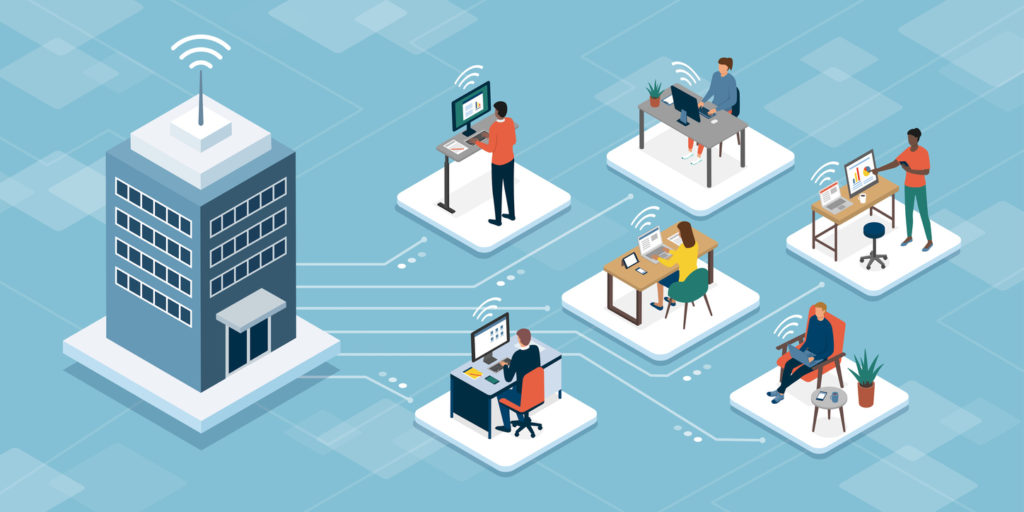At the end of the summer of 2021, I wrote about bringing people back to the office. At the time, some offices were thinking of opening back up in the fall. Little did we know that that the Omicron variant of COVID-19 would derail plans once again. In the post, I argued that in order to move our work environment into its next iteration, we needed to be intentional. As you all know from your own lived experience, everyone being in the office is easy. Everyone being out of the office is moderately easy. A mix of people in and out of the office is a challenge.
How we work and where we work are shifting in fundamental ways. Our children and grandchildren will hear stories about large office buildings, 9 am to 5 pm work expectations, and the time suck we call commuting and barely believe that we lived this way. That is how fundamental our work habits will change.

My Facebook memories, the daily reminders of what I posted on this day in the past, has been filled lately with me lamenting having to take a day off because my kids were home from school due to bad weather. In northern Virginia, 5-6 inches of snow could mean no school for a week. I was clearly stressed at having to use my paid time off for these weather events when I would have much rather used them on vacations.
These posts were a good reminder to me that we should never go back to that time. Prior to March 2020, I hardly ever brought my laptop home from the office, we never had video calls, and most of my co-workers were physically in the same office space as me during common hours.
Today we are reimagining how work should be after enduring (and in some cases thriving) in an all-remote environment. That said, we are likely to be hybrid — some part working from home and some part in the office. As I have been pondering these questions and trying to be intentional about how my team works best together, I was interested to see that Cactus Communications has named Jason Morwick as Head of Remote-First. This feels pretty intentional and I had a few questions. Prior to Cactus, Jason co-founded FlexWork Global, a consulting company that helped organizations implement remote work programs. He is the co-author of three books on remote working, including Making Telework Work (2009), Workshift: Future-Proof Your Organization for the 21st Century (2013), and Remote Leadership: Successfully Leading Work-from-Anywhere and Hybrid Teams (2021).
What follows is my interview with Jason.
Many organizations are moving to more flexible work arrangements. I suspect this will look different for organizations across the spectrum. For Cactus, what does it mean to be “remote-first”?
For Cactus, remote-first is a culture that we want all our employees, or “Cactizens”, to embody. Remote-first opens the global talent pool and embraces an individual for their talent, regardless of where they are working from. We employ 1,200 Cactizens across 14 countries and have clients in more than 190 countries. Therefore, it’s not practical to have everyone co-located in an office. However, this doesn’t mean we are getting rid of our office locations. We view our offices as resources that local employees can use for a change of environment.
Even if a Cactizen chooses to use one of our offices, it is likely that they will be working with team members who are in different cities, different time zones or different countries. That’s why we want every Cactizen to think like a remote worker and not be constrained by time or distance.
Roughly how many employees were remote — meaning working from home or alternative workspaces — prior to the pandemic? Does this change require a big culture shift for the organization?
Prior to the pandemic, 15-18% of our employees were remote and the majority were all situated around one office location in Mumbai. Cactus had been thinking about going remote-first for a long time, and the pandemic just happened to accelerate the shift. Going from being office-based to fostering a remote-first culture is a big shift and will certainly lead to some changes.
For example, businesses can’t replicate what they used to do face-to-face over a video call, particularly when it involves brainstorming ideas and promoting creative thought. The degree of independence that comes with being a remote-first organization means that employees can come up with their own ideas first, meet with the team online and share them in real-time, perhaps with the help of a virtual whiteboard. Inevitably, this is more efficient, improves the quality of ideas, and accelerates innovation.
I am curious about how you’re handling compensation. As employees become less tethered to their previous locations, the workforce becomes more distributed. Will compensation be determined by where the remote employees live? Are there changes to the compensation based on employees now absorbing costs such as utilities and office needs at home?
We provide full flexibility for employees to live anywhere in the country they were hired from. The compensation remains the same for any location in that country. Depending on the infrastructure within a person’s country and their job role, we provide additional allowances or reimbursements for internet service or office needs at home.
In addition, we now offer signing bonuses of around 5% of annual compensation and employee stock ownership plans (ESOPs) for leadership positions.
You are probably one of the first people to have a job title that makes you head of remote. What do you hope Cactus will look like in 3 years? What advice do you have to other organizations?
In three years, I hope we are still growing the company and recruiting the best talent in the world, wherever we can find it. Cactus’ main goal is for employees to feel connected with one another and feel part of the company culture no matter how many miles separate them. People must be able to grow their careers within the company while also having the flexibility to spend time with family and friends or pursue passions outside of work.
To develop its remote-first model, Cactus surveyed its employees to better understand their work preferences and challenges. We found that 86% of employees wanted flexibility in how and where they worked and 38% wanting full-time remote work. We also trialed several remote practices to gain an insight on how being remote-first could work. This covered everything from the introduction of virtual whiteboards to a communications charter, the use of remote champions, asynchronous communication and, importantly, a remote-first handbook.
I would advise other organizations to understand how becoming remote-first can fit into their business strategy, what employee work preferences are, and what changes may be needed to transition the organization to the desired state.
I am curious how your organizations are making the shift from mostly in person to mostly hybrid. What have you tried? What is working? What did not work at all? I would love to hear your thoughts in the comments.



